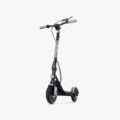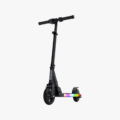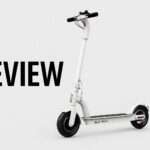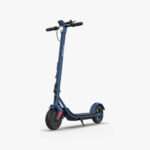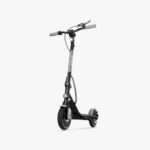- Home
- Scooters
- Electric Scooters
- Jetson Loomis
Jetson Loomis
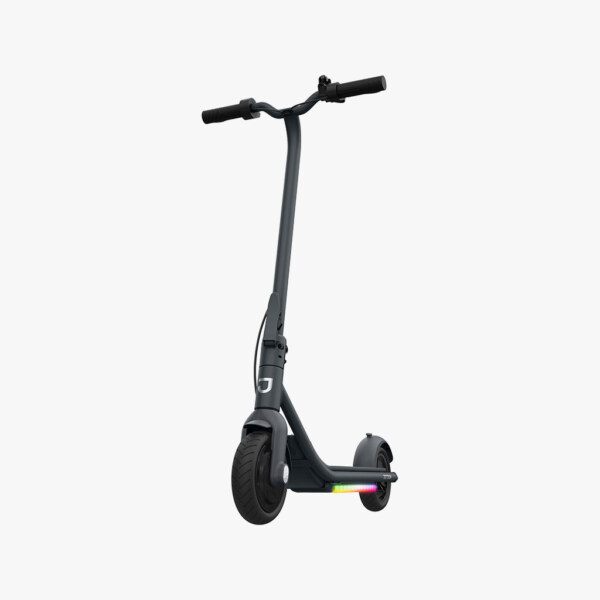

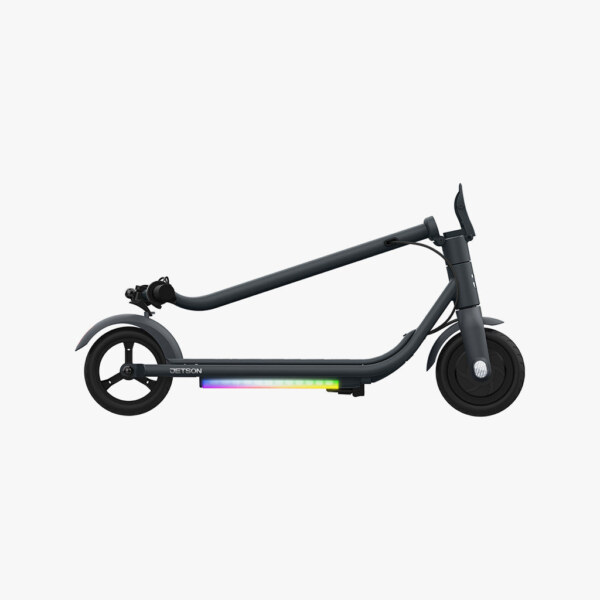
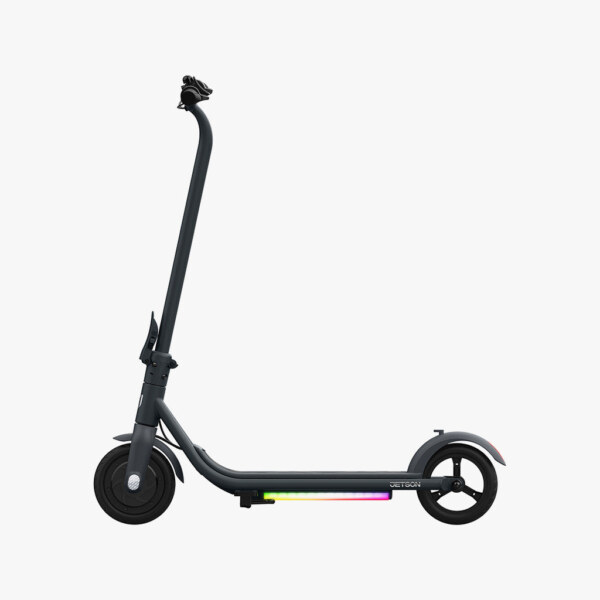
- Battery Range: 8 miles (13 km)
- Top Speed: 15.0 mph (24 km/h)
- Motor Power: 200 W
- Weight Capacity: 220 lb (100 kg)
- Charging Time: ≈6 h
- Scooter Weight: 24.2 lb (11.0 kg)
PROS
- 15.0 mph (24 km/h) top speed
- 8 miles (13 km) stated range
- 8 in solid tires
- Deck LEDs with music sync
- Bluetooth speaker
- Kickstand and bell
CONS
- Short real-world range
- Solid tires can feel harsh
- No suspension
- No companion app (speaker only)
Key Takeaways
- The Jetson Loomis is a lightweight, foldable electric scooter designed for teens and lighter adults, with a top speed of 15 mph.
- It features a 200 W front hub motor, 21.6 V lithium-ion battery, Bluetooth speaker, and under-deck RGB lights for a fun experience.
- This scooter offers three riding modes for beginner to experienced users, with a range of about 4 to 8 miles depending on conditions.
- The design prioritizes portability, making it easy to carry and store, ideal for short urban trips and campus commutes.
- While excellent for flat surfaces and fun rides, the Jetson Loomis isn’t suitable for steep hills or rough terrain.
Table of contents
- What Is the Jetson Loomis?
- How the Jetson Loomis Works
- Key Specifications
- Design & Build Quality
- Performance Fundamentals
- Battery, Range & Efficiency
- Ride Quality & Comfort
- Braking & Safety Features
- Portability & Daily Usability
- Maintenance & Care
- Weather & Seasonal Considerations
- Jetson Loomis vs Alternatives
- Who the Jetson Loomis Is (and Isn’t) For
The Jetson Loomis is a compact, playful electric scooter for teens and lighter adults who want simple everyday rides. It feels light, folds fast, and keeps controls easy, so it fits short trips, campus routes, and relaxed commutes on flat ground. At the same time it adds colorful deck lights and a built-in speaker, so it sits right between a fun gadget and a practical ride.
What Is the Jetson Loomis?
The Jetson Loomis is a foldable stand-up electric scooter with a 200 watt front hub motor, 21.6 V lithium-ion battery, and 8 inch solid tires. It is rated for riders up to 220 lb (100 kg) and geared toward ages 12 and up. Top speed reaches about 15 mph, which is around 24 km/h, so it stays friendly for paths, school areas, and side streets.
You get a slim frame, a low deck, and a folding stem that locks down for storage or transport. Then you add under-deck RGB lights, a Bluetooth speaker, and simple controls, and you end up with a scooter that feels more personal than many entry models. It does not try to be a heavy commuter tank. Instead it focuses on light weight, easy carry, and short-range comfort.
How the Jetson Loomis Works
The setup is straightforward, so new riders pick it up in minutes.
A 200 W hub motor sits inside the front wheel. When you press the thumb throttle, the controller feeds power from the deck battery to the motor in smooth steps. The pull feels gentle at first, then steady, so the scooter never jumps out from under you.
Three riding modes cap speed and response. Start in the slowest mode for younger or nervous riders. Then move up once balance and brake timing feel natural. This stepped behavior keeps the ride controlled without extra menus or confusing settings.
Inside the deck you find a 21.6 V, 5.0 Ah pack, about 108 Wh. A matching charger connects to the charge port, and a full charge from low takes up to around 6 hours. For most users that means an overnight plug in, then a fresh pack in the morning.
Braking uses an electronic system at the front wheel. When you hit the control, the motor resists rotation, so the scooter slows in a smooth arc. It feels soft and quiet. Riders should treat it like a gentle, predictable brake and plan a bit more road for stops at full speed.
Key Specifications
The table below groups the core specs in a way that is easy to scan and compare.
| Block | Detail |
|---|---|
| General | Model: Jetson Loomis. Recommended age: 12+. Max rider weight: 220 lb (100 kg). Intended for paved surfaces. |
| Performance & Power | Motor: 200 W front hub. Drive: front wheel. Top speed: up to 15 mph (24 km/h). Three riding modes. |
| Battery, Charging & Electrical | Battery: 21.6 V, 5.0 Ah (approx. 108 Wh) lithium-ion. Charge time: up to about 6 hours with dedicated charger. Charge port on deck area. |
| Build & Dimensions | Approx weight: 24.2 lb (11 kg). Unfolded: about 36.8 x 16.9 x 40.3 in (93.5 x 42.9 x 102.4 cm). Folded: about 36.8 x 16.9 x 18.9 in (93.5 x 42.9 x 48 cm). Deck length: about 18 in (45.7 cm). Deck width: about 6 in (15.2 cm). |
| Safety & Control | Electronic front brake. Thumb throttle. Bell. 8 in solid tires. Basic reflectors and lighting for visibility support. |
| Features & Extras | RGB under-deck LED lighting. Integrated Bluetooth speaker. Kickstand. Multi-mode ride control. Simple status indicators. |
| Warranty & Compliance | Limited warranty on frame and electrical parts per Jetson policy for this category. Local rules vary by region. |
Design & Build Quality
The Loomis frame follows a clean, simple line. The folding stem locks into a hinge at the base, and the latch position is obvious, so you can see at a glance if it sits right. Check it with one quick pull before each ride, and the front end stays tight.
The deck offers enough room for a natural staggered stance. One foot points forward, the other rests slightly sideways behind. For most riders, that space feels stable and relaxed. Grip on the deck surface keeps shoes in place even when the ground gets a bit rough.
Bar height matches teens and average-height adults well. So you stand upright without hunching. Very tall riders might find it a touch low on longer rides, yet for short trips it still works. The cockpit stays uncluttered. On the right side sit the thumb throttle and mode control. On the left side you find the brake control and bell.
Plastic trims around the speaker and RGB lights feel like typical consumer gear. Treat the scooter kindly when leaning it or packing it in a trunk, and those parts hold up. The metal frame supports its rated load when used as intended on smooth paths and streets.
Performance Fundamentals
On flat ground the Jetson Loomis behaves exactly like a light city scooter. The 200 W motor pulls you off the line at an easy pace. It does not snap, so new riders feel safe. As speed builds, the scooter cruises close to its 15 mph cap without strain for lighter and mid-weight riders.
Steering feels quick, since the scooter is light and the wheelbase is short. At the same time the low deck keeps your weight close to the ground, so you feel planted in normal turns. Small bar inputs bring clean direction changes, which helps in crowded paths and tight corners.
Then you hit hills and notice the limits. On gentle grades around 7 percent, lighter riders still move, but speed drops. On longer or steeper runs in the 8 to 10 percent range, heavy riders can crawl or stall. So this is not a hill crusher. It belongs in flat cities, campuses, and suburbs where climbs stay short.
As long as the hinge is snug, stem wobble at top speed stays low. If you ever feel play at the front, close the latch again and check bolts before riding fast.
Battery, Range & Efficiency
The small pack shapes real-world range, and that is fine as long as you plan for it.
On paper you see up to about 8 miles, roughly 13 km, in light use. That number assumes a light rider, warm weather, low mode, smooth pavement, and gentle starts. In daily life conditions shift, so treating that figure as a best-case guideline makes sense.
Several factors change how far you go:
- Heavier riders draw more current.
- Riding full speed the whole time drains faster.
- Repeated stops, bumps, and slopes raise power use.
- Headwinds and cold air chip away at the pack.
For many owners a realistic comfort zone lands near 4 to 6 miles (6 to 10 km) per charge. That range fits local errands, school runs, or short commutes with margin left.
Good habits help the battery age more slowly. Plug in after rides instead of running it flat all the time. Store the scooter indoors when you can, away from heat and damp. Pull the charger once full. If you take a break for some weeks, keep the battery sitting at a middle charge rather than empty.
Ride Quality & Comfort
The Loomis runs on 8 inch solid tires with no air inside. So you never fix flats from glass or small nails. On smooth pavement the ride feels tight and controlled with clear feedback from the ground.
On cracked streets, brick, or rough patches, you feel more of the surface. There is no suspension fork or rear shock to soak up harsh hits. Comfort then comes from how you ride. Bend your knees a bit, shift weight over bumps, and pick cleaner lines. For short trips this active stance stays easy to keep.
The deck height helps comfort. It sits low, so your knees and hips rest in a natural bend. Bar width feels balanced too. You get enough leverage without feeling stretched, which matters for younger riders.
If you sense any flex or click at the stem, take a minute to close the latch tight and check bolts. A firm front end is key for a calm feel at speed.
Braking & Safety Features
Braking on the Jetson Loomis uses an electronic system at the front wheel. Tap the control and the motor switches from drive to resist. That drag slows the scooter in a smooth, steady curve. It feels predictable, not aggressive, which matches the top speed and target riders.
Safe stops need a bit of planning. Start braking earlier when you ride at full speed. Keep both hands on the bar. Shift your weight a little back, keep your knees bent, and look ahead. On dust, wet patches, or painted lines, roll off speed before you reach trouble spots.
Safety helps include:
- RGB under-deck lights that boost side visibility.
- A bell to warn pedestrians or slower riders.
- Basic reflectors that add some passive visibility.
For real night riding, many owners add stronger front and rear lights and some reflective gear. The stock setup helps you be seen, yet your habits and protective gear do most of the work.
Water use should stay careful. Light splashes from dry streets are one thing. Deep puddles, heavy rain, or soaking the deck raise risk for grip loss and long-term damage. Ride smart and slow if the ground turns damp, or walk it indoors.
Portability & Daily Usability
Portability is where the Loomis shines day after day.
At about 24.2 lb (11 kg), most riders carry it with one hand for short stretches. So stairs, train platforms, and office lobbies feel easy. The fold takes a short sequence: open latch, drop stem, secure. After a few days it becomes muscle memory.
The folded footprint fits tight spaces. Slide it under a desk, lean it in a hallway corner, or drop it into a trunk without a puzzle. For students in dorms or renters in small apartments, that compact shape removes the storage headache that bigger scooters bring.
Daily use patterns that match well:
- Home to bus, bus to campus.
- Short urban links where parking a car would take longer.
- Shared household use between siblings in safe areas.
For security, pair the scooter with a small, solid lock when left outside. Do not leave it exposed for long stretches. Take it indoors at night when possible to protect both hardware and battery.
Maintenance & Care
The Loomis keeps maintenance simple, yet a basic routine pays off.
Before each ride:
- Check the folding latch for full lock.
- Wiggle the bar to confirm no looseness.
- Test brake response at walking speed.
- Look at the tires for cracks, cuts, or big debris.
Each week:
- Wipe dust off the deck, lights, and speaker grille.
- Check bolts at the stem, deck, and wheels for movement.
- Look over cables for rubbing or pinching.
Each month:
- Listen for odd noises from wheels or stem.
- Check the charge port cap for a snug fit and clean seal.
- Scan the RGB lights and speaker for normal behavior.
Solid tires remove tube puncture work, yet they can still wear or chip. Change them if you see deep damage. If braking feels weaker than usual, ride slow and review the manual or support steps before pushing speed again.
Store the scooter in a dry room. Keep it away from long soaking humidity or direct strong heat.
Weather & Seasonal Considerations
Season and weather shape how the Jetson Loomis feels on the road.
In mild dry conditions range stays close to its best, and grip feels steady. Many owners see their smoothest rides in spring and fall. Summer heat is fine if you avoid leaving the scooter baking in parked cars or under direct sun for long hours.
Cold weather cuts range. As temperature drops, the battery delivers less energy, and solid tires stiffen. So plan shorter trips, start with the scooter warmed indoors, and ride with extra care on frosty or dusty patches.
Rain is where you slow down or stop. Small hard tires slide easier on wet paint, tiles, and metal covers. Deep puddles carry a risk for both traction loss and water reaching sensitive parts. If you must ride after light rain, lower speed, pick clean lines, and keep braking smooth.
Rules for electric scooters change from place to place. Check local guidance on helmets, age limits, and where you can ride, then shape your habits around that.
Jetson Loomis vs Alternatives
Viewed inside its category, the Loomis sits as a light, fun, short-range scooter with style touches.
Bigger commuter scooters pack stronger motors, taller stems, and larger batteries. They climb better and cover more miles in one run. At the same time they weigh far more, take more space, and feel clumsy on stairs or in small homes. So if you carry your scooter daily or share it with younger riders, the Loomis style can make more sense.
Bare-bones entry scooters often skip lighting effects and speakers. The Loomis adds those features without turning into a heavy machine. Riders who care about simple self-expression on rides will enjoy that mix.
For performance or rough ground, the Loomis is not the pick. Off-road and high-power models add big pneumatic tires, wide decks, and strong dual brakes. They handle fast speeds and broken pavement. The Loomis belongs on city paths, school routes, and smooth streets.
If you want a different flavor inside the same brand family, a model like the Jetson Racer brings a more playful seated format. For a stronger commuter-style ride, the Jetson Eris steps closer to classic adult commuting needs with more serious road focus.
Who the Jetson Loomis Is (and Isn’t) For
The Jetson Loomis is a smart fit for:
- Teens ready for their first real electric scooter with clear limits.
- Students who ride between dorms, classes, and transit stops.
- Riders who travel about 2 to 5 miles (3 to 8 km) a day on mainly flat routes.
- People who want a scooter they can fold fast, carry easily, and tuck indoors.
- Casual users who enjoy RGB lights and music while they ride.
The Jetson Loomis is not the best match for:
- Daily riders on steep hills or long bridge climbs.
- Heavier riders who expect strong acceleration on every slope.
- Commuters who need 10+ miles (16+ km) of reliable range in one shot.
- People who ride in deep night conditions and never plan to upgrade lights.
- Riders who want a soft, floating feel on broken roads or gravel paths.
Matched with the right rider and environment, it does its job cleanly. It stays light, simple, and fun without pretending to be more scooter than it is.
Specifications
General
| Model The Model specifies the exact version or name of the scooter. It helps identify its unique design, features, and specifications within the manufacturer’s product line. Knowing the model makes it easier to compare options, find compatible accessories, or look up support information. | Loomis |
| Brand The Brand identifies the manufacturer or company that designs and produces the scooter. A trusted brand is a sign of quality, reliability, and good customer support. Well-known brands often have higher standards for safety, performance, and after-sales service, giving you more confidence in your purchase. | Jetson |
| Release Date The Release Date indicates when the scooter model was officially launched on the market. This helps you know how current the design, technology, and features are. A newer release date often means updated components, improved performance, and the latest safety or smart features. | 18 November 2025 |
| Recommended Age Recommended Age indicates the minimum age range that the scooter is designed for, based on safety, size, and ease of use. Following the recommended age helps ensure that riders can handle the scooter’s speed, weight, and controls comfortably and safely. Always check local laws and use protective gear, especially for younger riders. | 12+ |
Performance & Power
| Motor Power (Wattage) What it means: The motor power, measured in watts (W), shows how strong the scooter’s electric motor is. Why it matters: Higher wattage usually means better acceleration, more torque, and improved performance on hills or rough terrain. For example, a 250W motor is good for flat city roads and light riders, while a 500W or 1000W motor provides more power for faster speeds or climbing steep inclines. | 200 W hub motor |
| Top Speed The Top Speed indicates the maximum speed that the scooter can reach under optimal conditions. It’s usually measured on level ground with a fully charged battery and an average rider weight. A higher top speed allows you to travel longer distances faster, but always ensure you ride within legal speed limits and your personal comfort zone for safety. | 15.0 mph (24 km/h) |
| Battery Capacity Battery Capacity refers to the total amount of energy the scooter’s battery can store, usually measured in ampere-hours (Ah) or watt-hours (Wh). A higher battery capacity means you can ride longer distances on a single charge, reducing the need for frequent recharging. Keep in mind that actual range can vary depending on rider weight, terrain, speed, and weather conditions. | 21.6 V 5.0 Ah (108 Wh) |
| Estimated Range per Charge The Estimated Range per Charge indicates the average distance the scooter can travel on a single full battery charge. This range is calculated under optimal conditions, such as flat terrain, moderate speed, and average rider weight. Real-world range may vary depending on riding style, terrain, weather, and load. A longer range means fewer recharges and greater freedom for longer trips. | 8 miles (13 km) |
| Hill Climb Ability Hill Climb Ability describes the maximum incline or slope that the scooter can handle while maintaining stable performance. It’s typically expressed as a percentage or in degrees. A higher hill climb rating means the scooter can tackle steeper hills without losing too much speed or power. Actual climbing performance may vary based on rider weight, battery charge, and terrain conditions. | Not specified |
| Drive System The Drive System refers to how power from the motor is delivered to the wheels. Electric scooters typically use either a hub motor (directly integrated into the wheel) or a chain/belt drive system. A high-quality drive system ensures smooth acceleration, efficient power transfer, and low maintenance. The choice of drive system affects performance, noise level, and overall ride experience. | Not specified |
Charging & Electrical
| Charging Time Charging Time indicates how long it takes to fully recharge the scooter’s battery from empty to 100% using the standard charger provided. Faster charging means less downtime and more time on the road. Actual charging time may vary slightly depending on battery capacity, charger output, and environmental conditions. | Approx. 6 h |
| Battery Type Battery Type refers to the specific technology used in the scooter’s battery, which affects performance, lifespan, weight, and charging time. Most modern electric scooters use high-quality lithium-ion (Li-ion) batteries because they offer a good balance of energy density, durability, and low maintenance. A reliable battery type ensures consistent power delivery and longer riding ranges. | Lithium-ion battery |
| Removable Battery A Removable Battery means the battery pack can be easily detached from the scooter for convenient charging and replacement. This feature allows you to charge the battery separately, swap it with a spare for extended range, or securely store it indoors in extreme weather. Removable batteries add flexibility and make it easier to keep your scooter powered up wherever you are. | Non-removable internal battery (fixed pack) |
| Regenerative Braking Regenerative Braking is an energy-saving feature that converts some of the energy normally lost during braking back into battery power. When you slow down or brake, the motor works in reverse to generate electricity, which helps extend the scooter’s range and improves overall efficiency. This system also reduces wear on traditional brake components, leading to lower maintenance over time. | Not specified |
| Lighting Lighting refers to the built-in front and rear lights that enhance visibility and safety when riding in low-light conditions or at night. Good lighting helps you see the road ahead and ensures that other road users can see you. Many scooters include LED headlights, taillights, and sometimes brake lights or side reflectors for added safety and compliance with local traffic regulations. | Under-deck LED lighting; lighting effects via speaker sync |
Build & Dimensions
| Scooter Weight Scooter Weight refers to the total weight of the scooter when fully assembled, including the battery. This affects how easy it is to carry, lift, and store the scooter when not in use. A lighter scooter is more portable and convenient for commuting, especially if you need to carry it upstairs or onto public transport. Keep in mind that a sturdy frame and quality components may add to the weight but also contribute to better durability and ride stability. | 24.2 lb (11.0 kg) |
| Maximum Rider Weight Maximum Rider Weight indicates the highest rider weight that the scooter is designed to safely support while maintaining optimal performance and stability. Staying within this limit helps ensure reliable acceleration, braking, and climbing ability, and it protects the frame, suspension, and motor from excessive strain. Exceeding the recommended limit may reduce performance and increase wear on components. | 220 lb (100 kg) |
| Deck Size Deck Size refers to the dimensions of the scooter’s standing platform. A wider and longer deck provides more foot space, allowing you to stand comfortably and adjust your stance while riding. A well-sized deck improves balance and stability, especially on longer rides or at higher speeds. Compact decks, on the other hand, help keep the scooter lightweight and portable. | Compact deck for teens |
| Handlebar Height Handlebar Height refers to the distance from the deck to the handlebars, which affects your riding posture and comfort. An appropriate handlebar height helps you maintain good balance, reduces strain on your back and arms, and makes steering more comfortable. Some scooters have adjustable handlebars to fit riders of different heights, while others have a fixed height for a streamlined design. | Fixed |
| Folding Mechanism The Folding Mechanism describes how easily and securely the scooter can be folded for carrying and storage. A well-designed folding system lets you quickly collapse the scooter into a compact size, making it convenient to transport on public transit, store under a desk, or fit into a car trunk. Look for sturdy latches and safety locks to ensure the scooter stays firmly in place when folded or unfolded. | Half-folding stem latch |
| Dimensions Folded Dimensions indicate the size of the scooter when it’s fully folded. This measurement shows how much space the scooter will take up when stored or carried, making it easier to check if it will fit in your car trunk, under a desk, or in a closet. Compact folded dimensions are ideal for commuters who need to bring their scooter on public transport or store it in tight spaces. | Unfolded: 36.8 x 16.9 x 40.3 in | Folded: 36.8 x 16.9 x 18.9 in |
| Material Material refers to the primary construction materials used for the scooter’s frame and key components. High-quality materials like aircraft-grade aluminum, reinforced steel, or durable composites provide strength, stability, and a lighter overall weight. A sturdy material ensures the scooter can handle daily wear and tear while maintaining safety and performance. | Not specified |
Safety & Control
| Brake Type(s) Brake Type(s) describe the braking systems the scooter uses to help you slow down or stop safely. Common brake types include mechanical brakes (like drum or disc brakes), electronic brakes, and foot brakes. Many scooters combine multiple braking systems for added safety and shorter stopping distances. The type and quality of brakes affect your control, especially when riding at higher speeds or on slopes. | Electronic e-brake |
| Suspension Suspension refers to the system that absorbs shocks and vibrations while riding, providing a smoother and more comfortable ride over uneven or rough surfaces. Scooters may have front suspension, rear suspension, or dual suspension for better shock absorption and stability. Good suspension helps reduce rider fatigue and improves control, especially when riding on bumpy roads or off-road paths. | None |
| Tire Type Tire Type refers to the kind of tires the scooter uses, which directly affects ride comfort, traction, and maintenance. Common types include solid (airless) tires, pneumatic (air-filled) tires, or hybrid options. Pneumatic tires offer better shock absorption and a smoother ride on rough surfaces, while solid tires are puncture-proof and require less upkeep. The right tire type helps ensure safe handling and a comfortable ride in different conditions. | Solid 8″ |
| Tire Size Tire Size indicates the diameter and width of the scooter’s tires, which affect ride comfort, stability, and how well the scooter handles different terrains. Larger tires generally offer better shock absorption and a smoother ride over bumps and rough surfaces, while smaller tires keep the scooter lighter and more portable. Choosing the right tire size helps ensure a balance between agility and comfort. | 8-inch |
| Kickstand The Kickstand is a built-in stand that allows you to park your scooter upright when it’s not in use. A sturdy kickstand keeps the scooter stable and prevents it from tipping over, protecting it from scratches and damage. It also makes storing and accessing your scooter more convenient, whether you’re at home, work, or on the go. | Side kickstand |
| Water Resistance Rating Water Resistance Rating indicates how well the scooter is protected against water and moisture, usually shown as an IP (Ingress Protection) rating. This rating helps you understand whether the scooter can handle light rain, splashes, or wet roads without damage. While most scooters are not fully waterproof, a good water resistance rating adds peace of mind when riding in changing weather conditions. Always avoid deep puddles or submerging the scooter to protect its electrical components. | Not specified |
Features & Extras
| Display/Console The Display (or Console) shows important real-time information about your ride, helping you monitor your scooter’s status at a glance. Typical displays show speed, battery level, distance traveled, and riding mode. Some models also include additional features like Bluetooth connectivity, app integration, or backlighting for better visibility at night. A clear and easy-to-read display enhances safety and convenience on every trip. | Battery indicator LEDs |
| Ride Modes Ride Modes refer to the different speed and power settings you can choose to match your riding style or road conditions. Common modes include eco for maximum range and energy efficiency, standard for everyday balance, and sport or turbo for higher speed and stronger acceleration. Switching between ride modes allows you to customize performance, conserve battery, and ride safely in various environments. | 3 riding modes |
| Smart App Connectivity Smart App Connectivity lets you pair your scooter with a dedicated mobile app via Bluetooth. Using the app, you can monitor real-time ride stats like speed, battery level, and range, adjust settings such as ride modes or cruise control, lock the scooter for added security, and sometimes receive firmware updates. This feature adds convenience and allows you to personalize your riding experience right from your smartphone. | None |
| Anti-Theft System The Anti-Theft System helps protect your scooter from unauthorized use or theft. This feature can include built-in alarms, electronic motor locks, GPS tracking, or remote locking through a mobile app. A good anti-theft system provides peace of mind when parking your scooter in public spaces, adding an extra layer of security to safeguard your investment. | None |
| Cruise Control Cruise Control allows you to maintain a steady speed without continuously holding the throttle. This feature makes longer rides more comfortable by reducing hand fatigue and providing a smoother, more relaxed riding experience — especially on flat, open roads or bike lanes. For safety, cruise control can usually be easily activated or deactivated while riding. | Not specified |
| Accessories Included Accessories Included lists the additional items that come with the scooter to enhance your riding experience and convenience. Common accessories may include a charger, kickstand, bell, lights, phone holder, or carrying strap. These extras add value by making your scooter safer, easier to use, and ready to ride straight out of the box. | Not specified |
Warranty & Compliance
| Warranty Period The Warranty Period indicates how long the manufacturer guarantees the scooter against defects in materials and workmanship under normal use. A good warranty provides peace of mind, showing the brand’s confidence in its product quality. Always check what parts are covered, such as the frame, battery, and motor, and follow the maintenance guidelines to keep your warranty valid. | 180 days |
| Certifications Certifications confirm that the scooter meets specific safety, quality, and environmental standards set by recognized organizations or regulatory bodies. Common certifications may include CE, RoHS, UL, or other local compliance marks, depending on your region. These certifications ensure that the scooter is manufactured to high standards and is safe and legal to use in your country. | Region-dependent |


